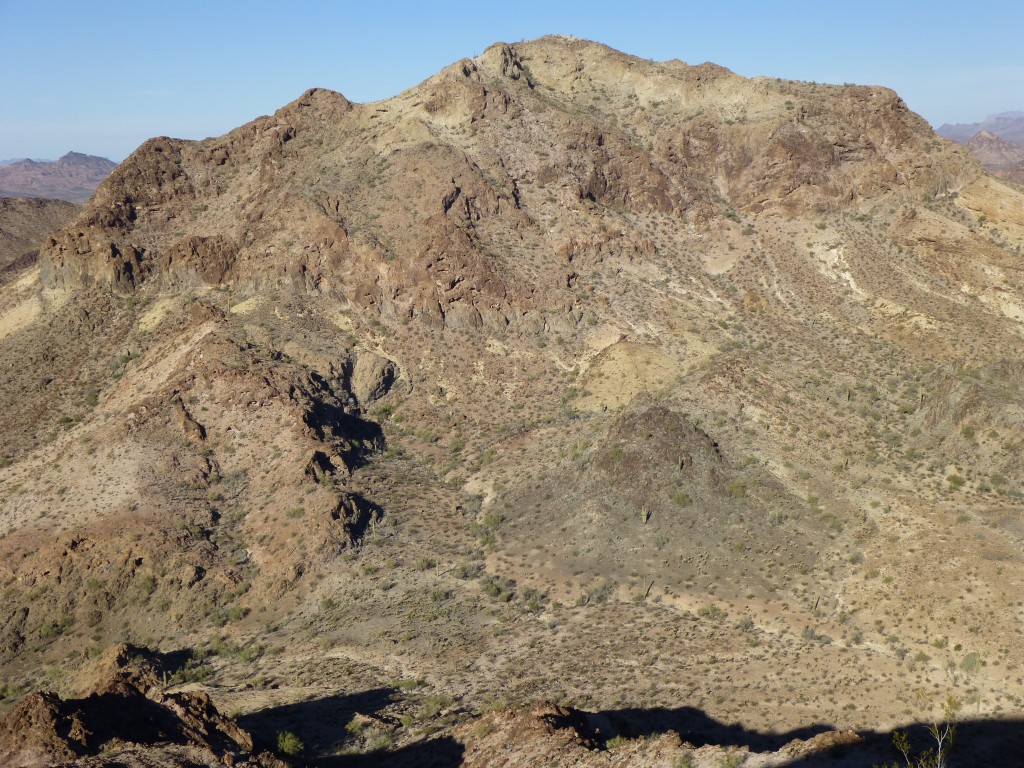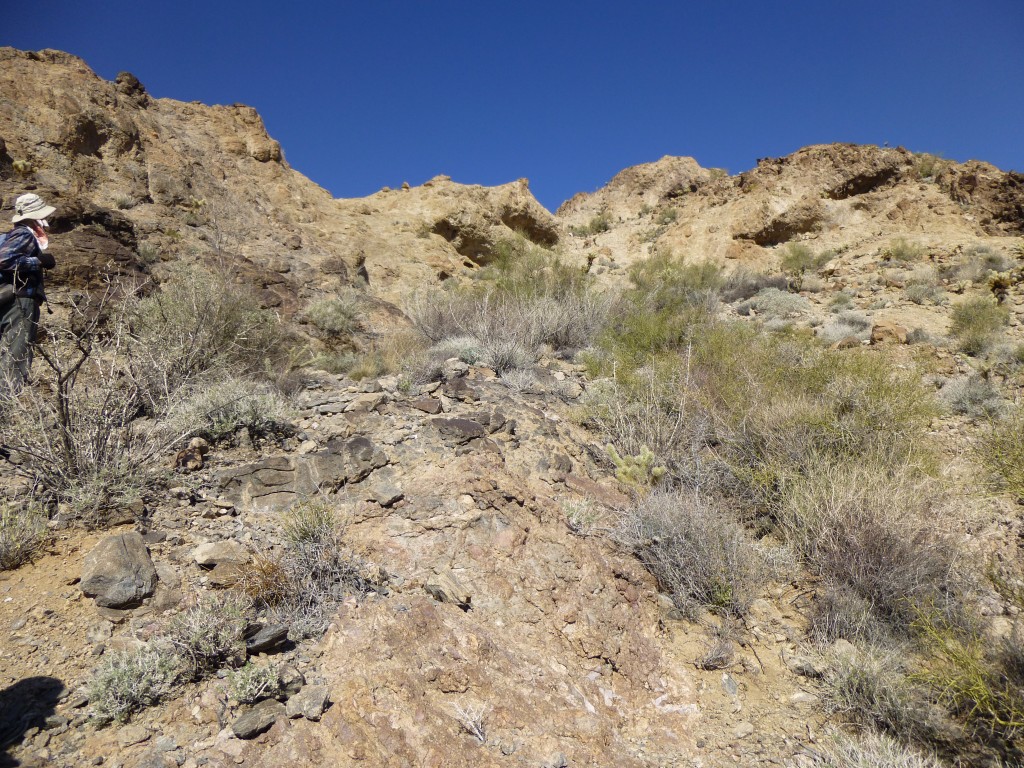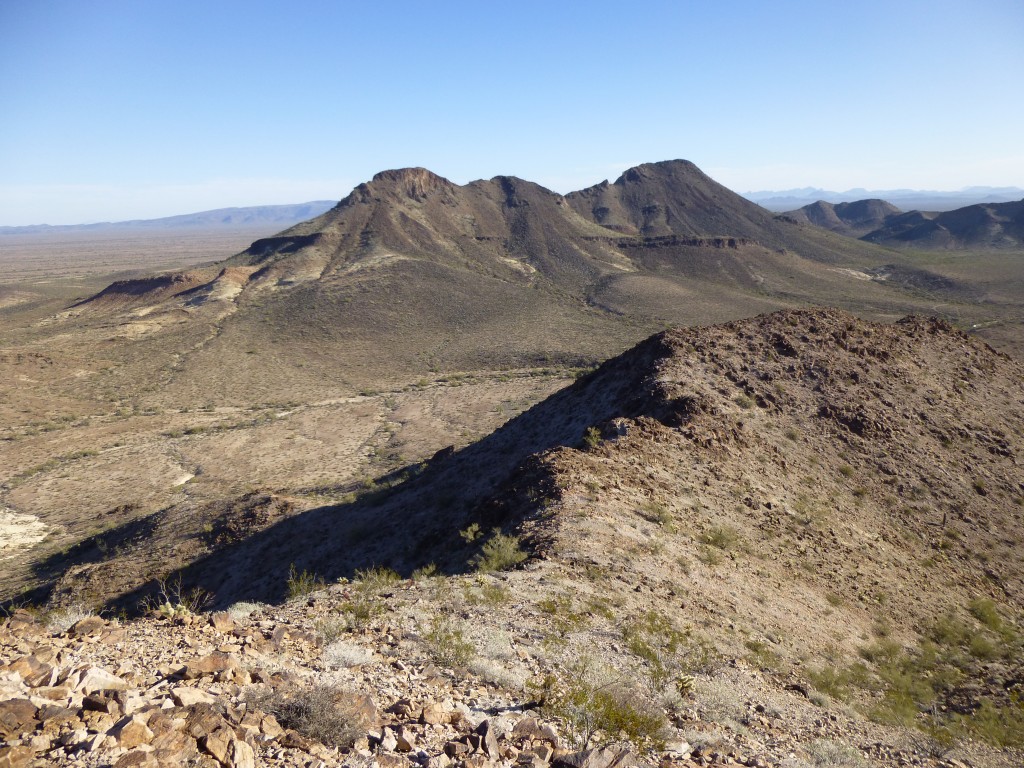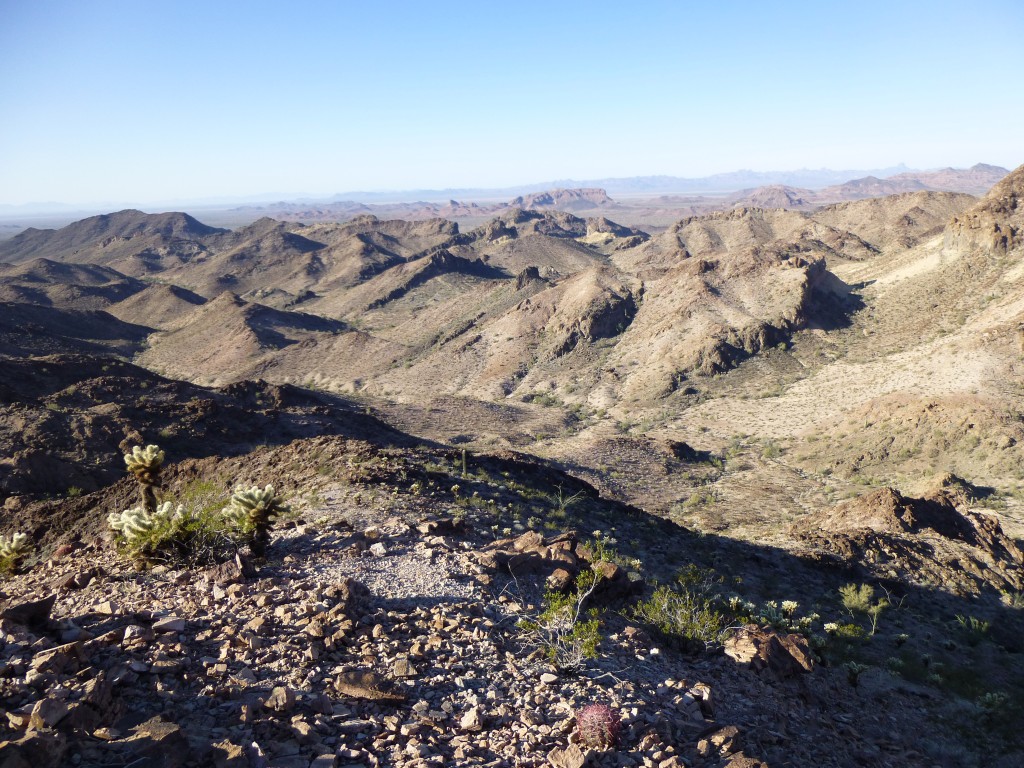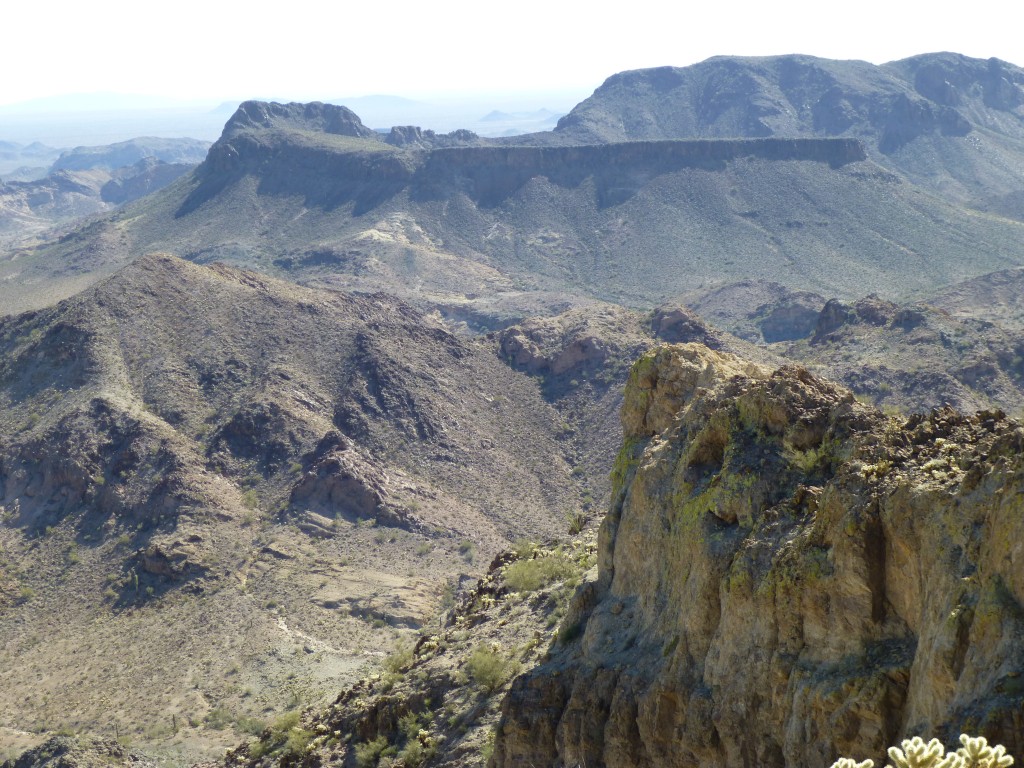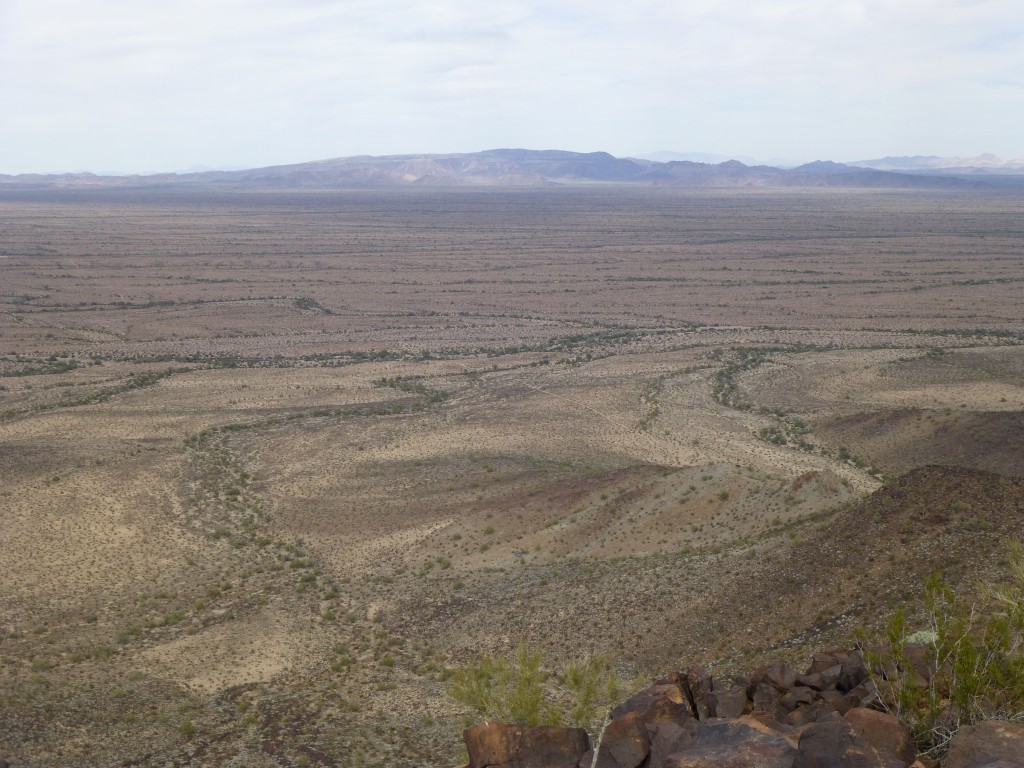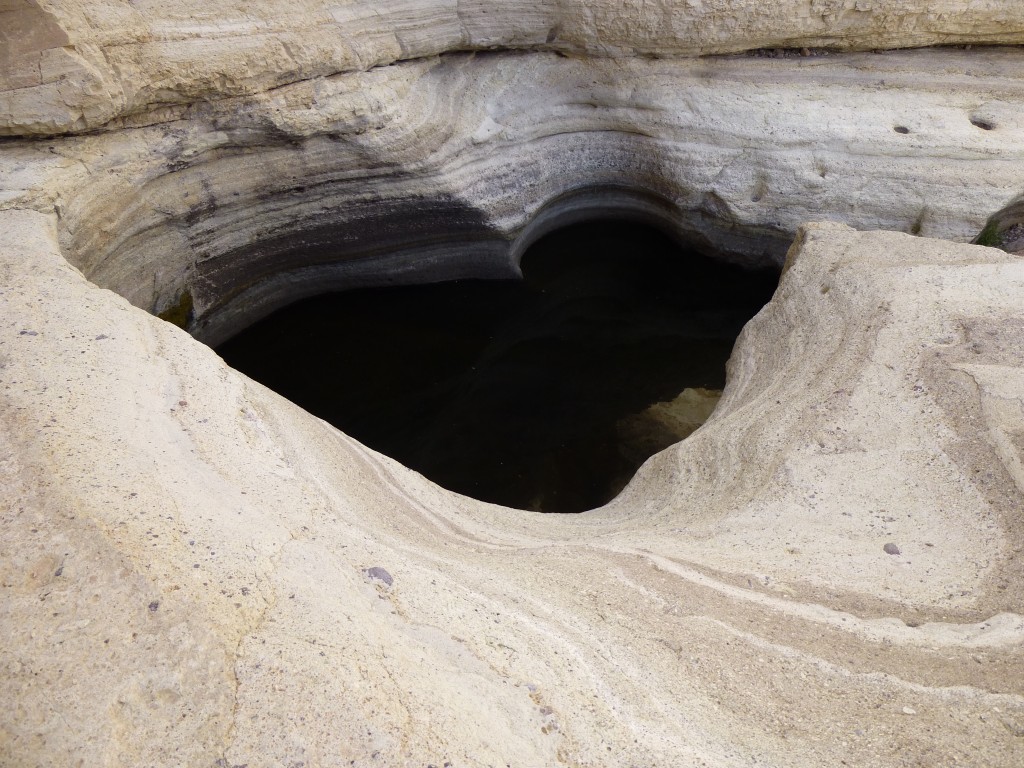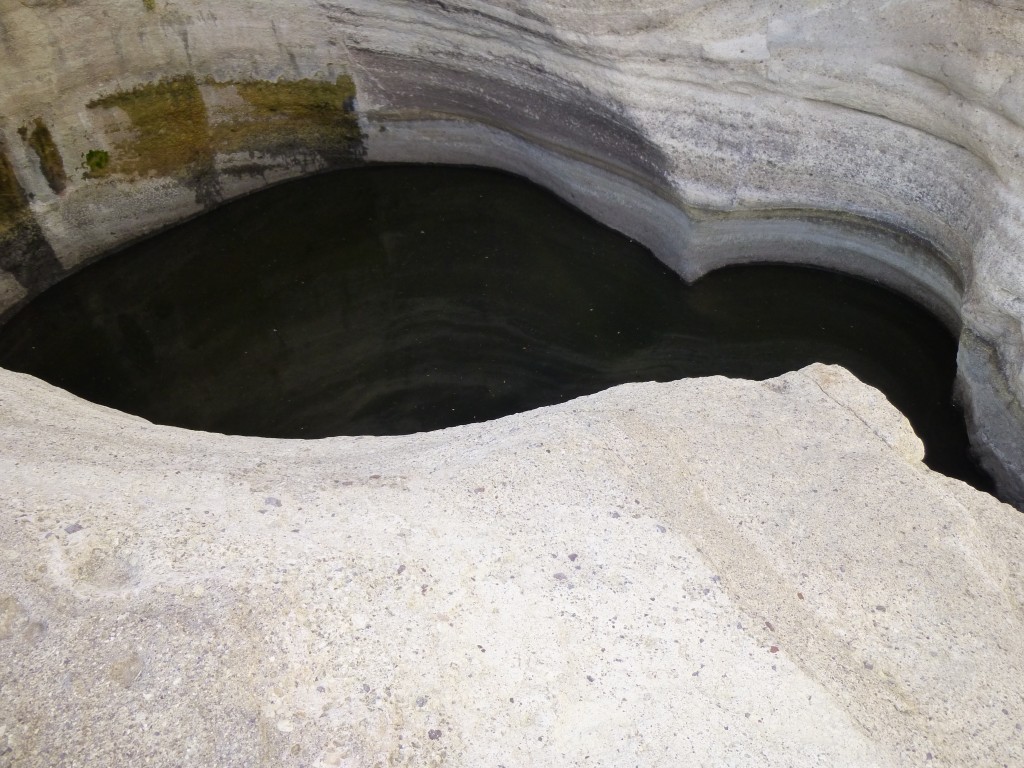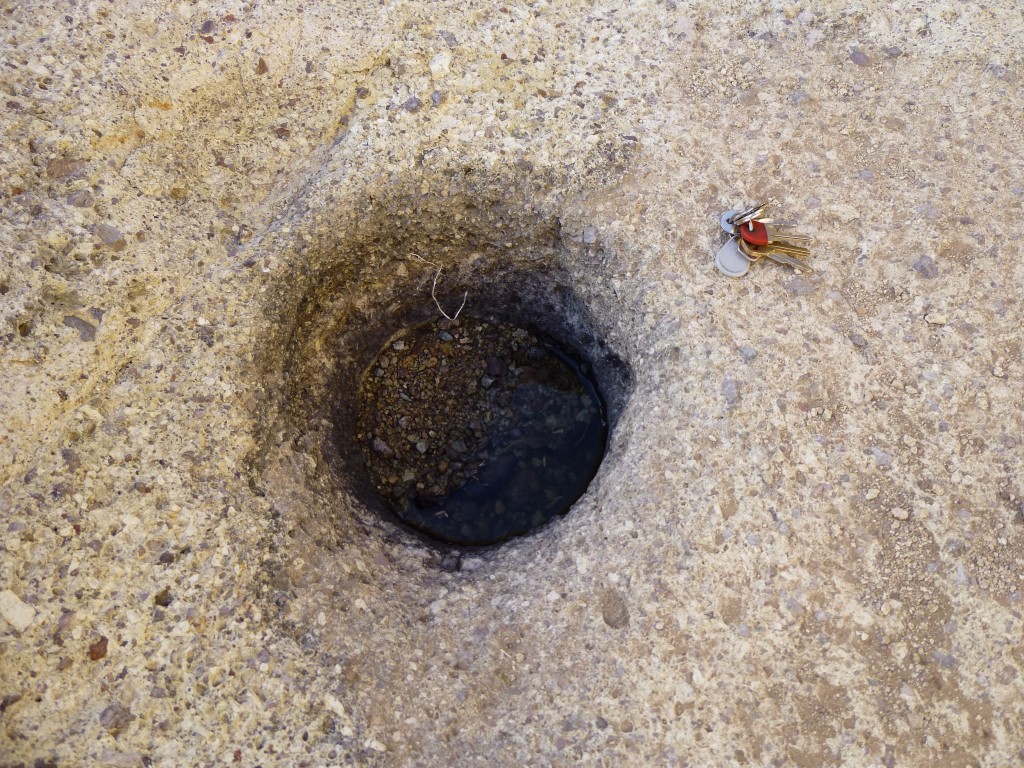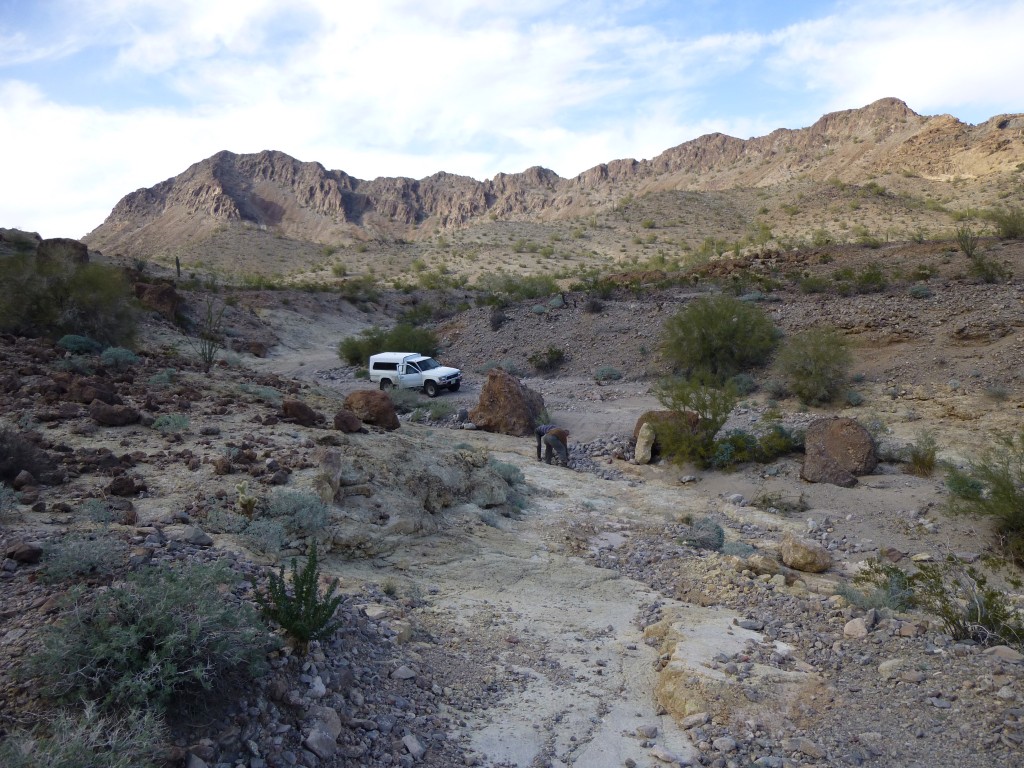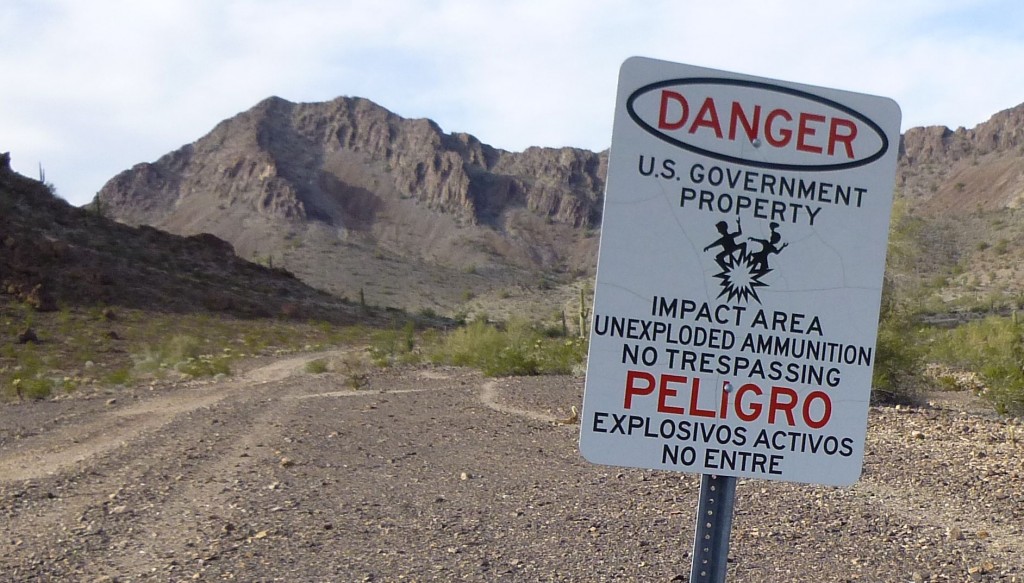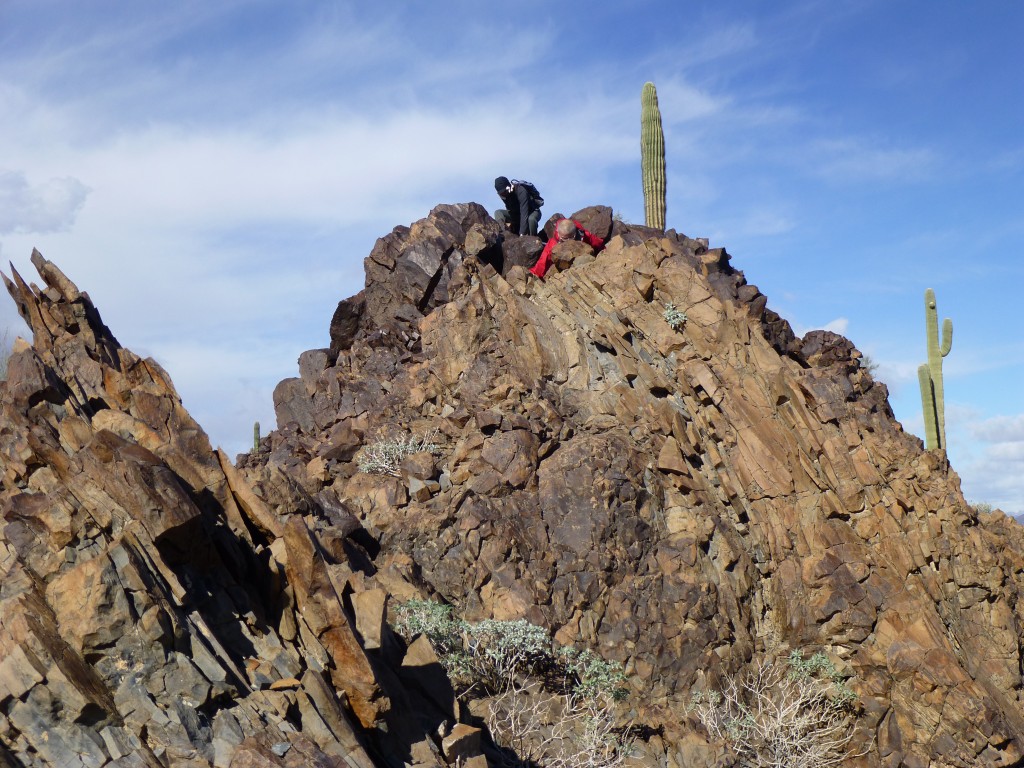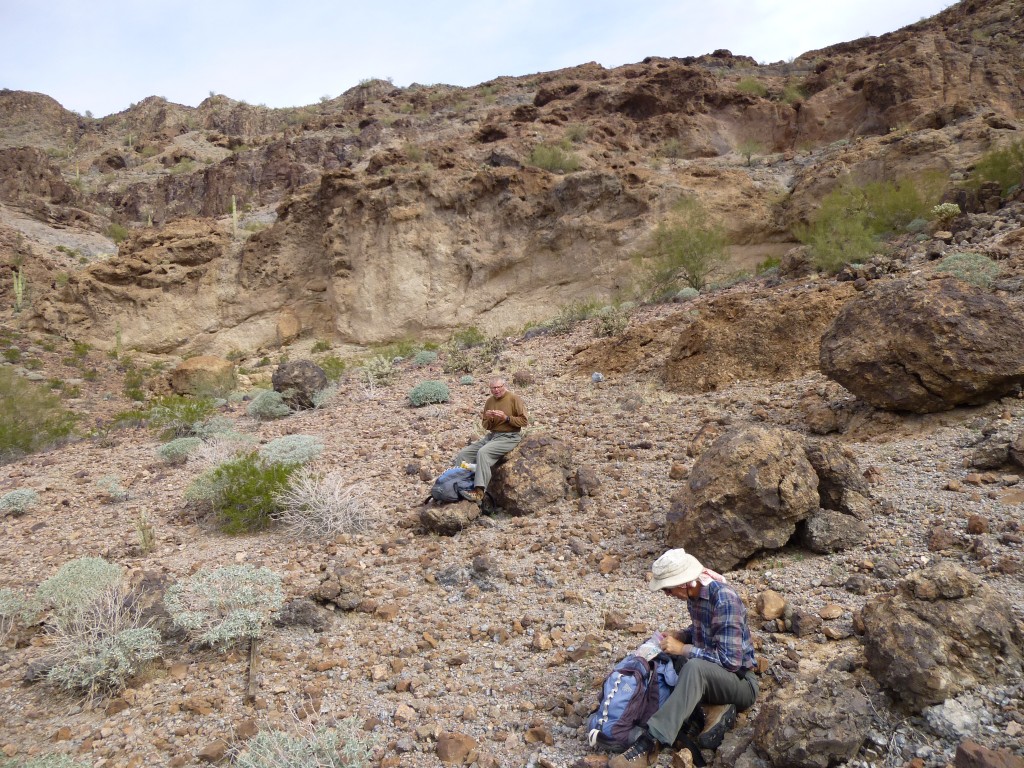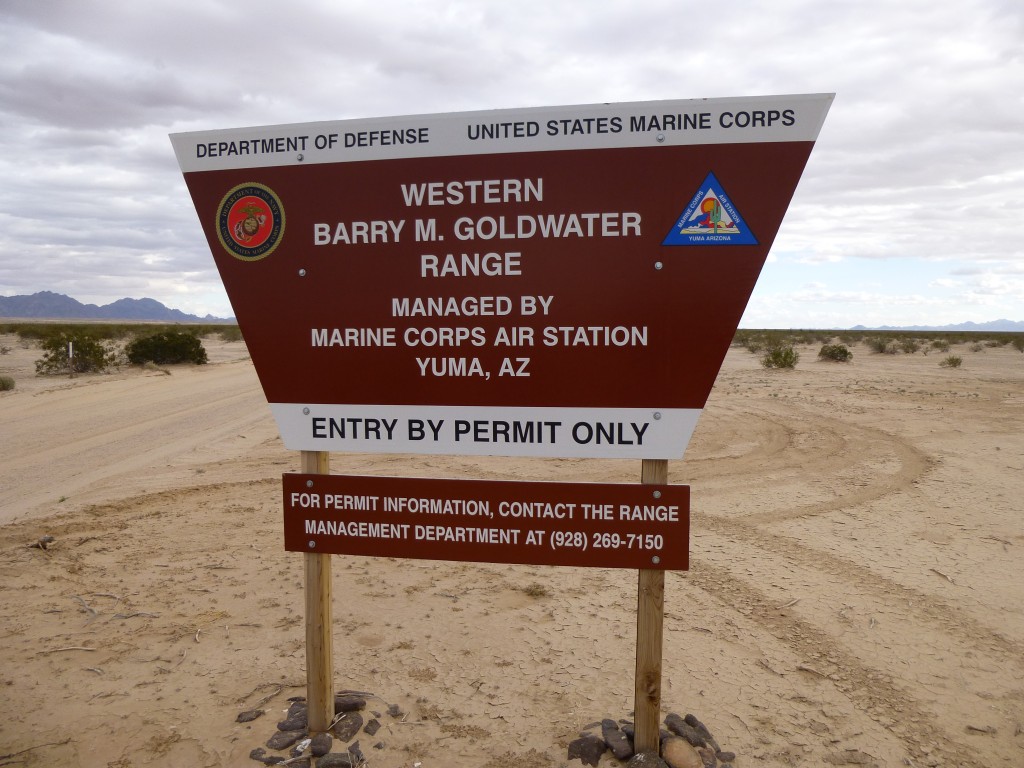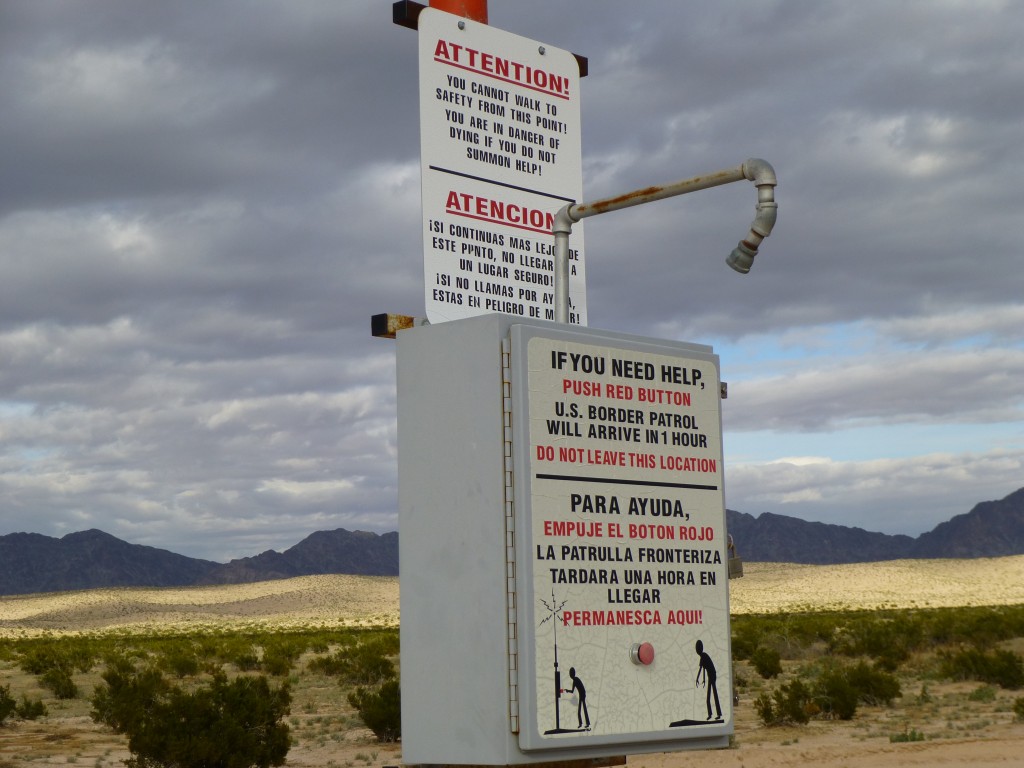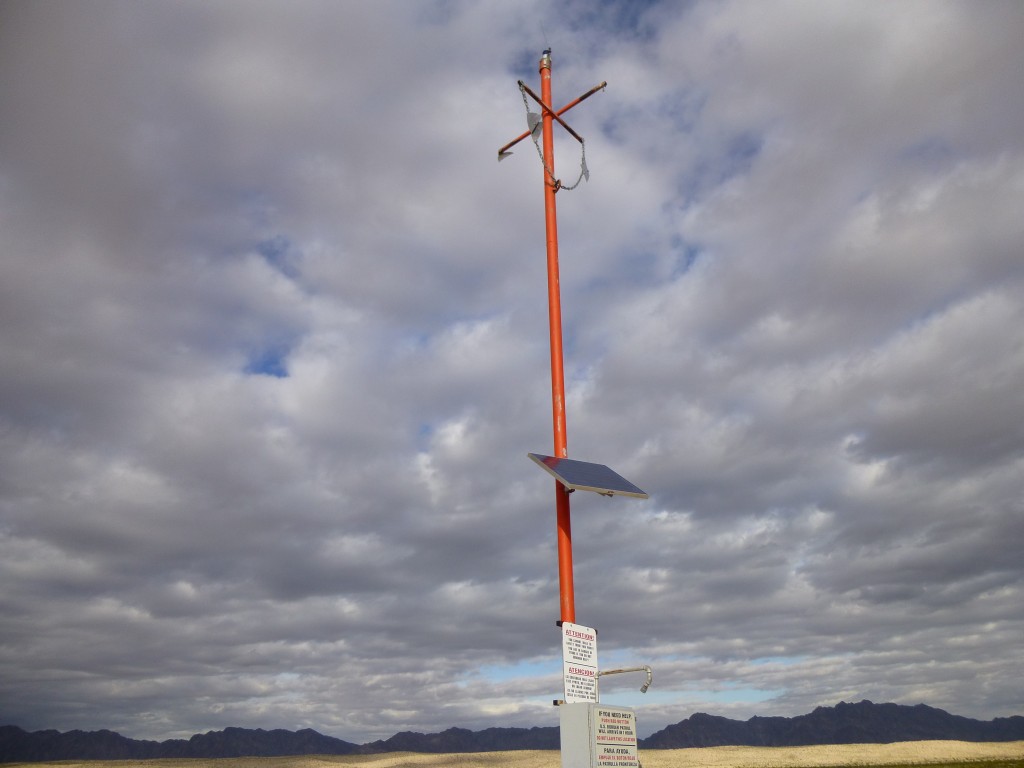The next day dawned clear and chilly. Once again, we stowed everything in the trucks and took off up a gentle wash. What a place! This valley was surrounded by amazing peaks, ripe for the picking. There was a feeling about it that other climbers hadn’t been here. As a warm-up, we decided to climb Peak 1903 on the south side of the valley. It went without incident. We built a cairn and left a summit register, all the while eyeing the real prize farther west.
The day had gotten off to a good start with a peak that seemed virgin territory. What would we find next? Across the valley, Peak 2172 required some time to plan – we glassed its entire east side, slowly and carefully. From our vantage point, we decided there was one route that looked like it could work. We dropped down to the valley floor and crossed over to the base of 2172. Even though this peak had 742 feet of prominence, its summit was still 500 lower than the city of Tucson – interesting perspective, huh?
The trick to this one was to climb up a steep gully, then cross a ridge at just the right spot, and make our way up through some cliffs. We figured it all out, and it went without a hitch, although there were some steep loose spots.
It was worth the effort. No sign of any previous visit up there, so we built another cairn and left a register. Look at these views from the summit!
And here’s a view looking southeast to Tanker Benchmark, which Mark and RHIker had climbed years before.
We hated to leave, but had more climbing to do, so we started down carefully, retracing our steps. Once back to the valley bottom, we followed a pretty wash all the way back to our trucks. A short drive took us to a higher area where we parked and did a quick climb of Peak 2168, itself having almost 700 feet of prominence. Amazing – we left a register there too. Here is a view from the summit, looking north across the Palomas Plain to the very distant Little Horn Mountains. Let’s just say you wouldn’t want to walk over to them in the summer unless you had a death wish.
Once back down at the trucks, we decided to drive over to see this thing that was called “White Tanks” on the map. It was only a short drive from where we were parked, and we figured we’d just come back out the way we’d come in once we’d seen the tanks. Just one problem – driving down a steep hill, the road became extremely rough and rather dangerous, so we knew we weren’t going to be able to drive back out that way again. We were committed to leaving the area by a different route.
It turned out that the tanks were some natural depressions in the rock which had probably been used as water sources for animals and also for early people living in the area.
These were deep, and could hold water through long dry periods. We also saw a couple of round holes in the rock, metate-like structures which were places where early peoples would grind foods such as nuts, seeds or grains.
This was all very cool to see, and we felt privileged to have had a glimpse. The tanks were hidden in a deep enclave in the native rock, and if you didn’t have a map to show you where they were, you’d never find them.
We felt it wouldn’t be right to camp near the tanks, so we decided to try to drive out of the area on a completely unknown road, one shown as 4wd on the map, so we were expecting the worst. And we weren’t disappointed, because the two miles we traveled took a lot of time. The road was horrible, non-existent in places. There was one last hill, a real doozy, bad enough that we all got out and walked it to figure out a strategy. It was complicated by a very tight Z-turn at the bottom, in deep sand. The hill itself was a long rocky slab covered in gravel and grit. The next photo shows some road alterations being made by the guys, and the hill is a lot steeper than the picture would lead you to believe.
Once at the top of the hill, everything changed. The terrain became completely flat, and a few hundred yards later, we realized we were leaving the Yuma Proving Grounds because we saw this sign facing the other way. I love the artwork on it, illustrating that bombs would, without prejudice, blow up women as well as men.
A short distance later, we parked in a flat spot near the road. Funny thing is that this campsite was only 3 1/2 miles from the one of the previous night – it seemed much farther. After beers and a hot meal, we climbed down into a steep-sided wash to get out of the wind and enjoyed a campfire for a few hours. Some clouds were moving in and it looked like we might get some rain, so we battened down the hatches for the night and turned in.
During the night, at around 5:00 am, it rained hard for a while, maybe an hour. By the time we got up, it had blown through and was clearing up again. We ate, loaded up the trucks and drove a short distance to park for our next peaks. There were two we had in mind, neither of them very far from the road, so we decided to make a loop of it. It was cool and windy, but clear, as we headed out. We kept hearing booming sounds in the distance, and I thought it was thunder. As time passed, though, the guys’ argument that it was the army firing artillery pieces made much more sense. Using a few drainages, we climbed over some low hills and approached the first peak. It wasn’t hard to reach the summit ridge, but once on it we had no option but to follow it directly to the summit, Peak 1767. Man, the wind was blowing hard! We left a register on it, then decided to take a different way down. Maybe a mistake. The ridge was very narrow and exposed, but the rock was good. Here’s a shot of the guys negotiating it.
We managed it okay, than dropped down a few hundred feet, where our options became few. The trick was to not get cliffed out. It took a while, and we did it, but were nevertheless glad to be done and over with it. Here we are having a snack below the cliffs.
We didn’t tarry long, and headed cross-country to our next one, Peak 1510. It was an easy climb and only took us a short while to reach the summit, where we left yet another register. From the summit back down to the trucks was the stuff of half an hour. That first beer tasted mighty fine.
Now what? It was Wednesday, the fifth day of our trip. Nothing would have pleased us more than to linger here in the Tank Mountains. With a total of 44 summits in the range, there was so much left to do. I had only done six of them, the guys a few more than that. But we had big plans for another range, the Mohawks, and we had to get a move on, to leave now if we were to get down there today. So, snacking as we drove, we continued southeast through the range on 4wd roads. Another eight miles took us back out on to the Palomas Plain where we met a slightly better road, then another hour delivered us to Snyder’s Well. Beyond that, another half-hour took us to the edge of some irrigated fields, and we soon hit a paved road. What a ride – we had completed a full hundred miles on rough dirt roads in the remote desert! We were now on the east side of the Palomas Mountains, and continued past more agriculture and huge solar farms, crossing the main line of the Southern Pacific Railway and finally arriving at the freeway at Dateland. Man, I really wanted to stop and get one of their world-famous date milkshakes, but there was no time. Thirty fast miles took us to our exit at Tacna, where we quickly gassed up and got ice and a few snacks.
No rest for the wicked. We were in familiar territory now, and headed east and south into the desert, passing along the west side of the Mohawk Sand Dunes. This sign greeted us soon after we left Tacna.
Thirty-three more miles of dirt roads, quite sandy in places, took us deep into the Mohawk Valley, around the southern extremity of the sand dunes, and to our final destination for the day, about a mile from Peak 1894. About the only thing of note along the way was this beacon. It has a light which flashes day and night, to attract those in trouble wandering in this unforgiving part of the Sonoran desert. Look at the sign it bears. The upper one says: “Attention! You cannot walk to safety from this point! You are in danger of dying if you do not summon help!” This is for real, folks – you can’t make this stuff up. A lot of people die out here each year – the desert is a cruel mistress.
The signs sit on this tower. A solar panel powers the emergency signal which is transmitted directly to the Border Patrol.
Please stay tuned for the next part of this adventure, to be called “The Mohawk Mountains”.
To be continued……………………………………………….
Please visit our Facebook page at https://www.facebook.com/pages/Desert-Mountaineer/192730747542690

